|
Bits and Pieces
by Bob Brooke
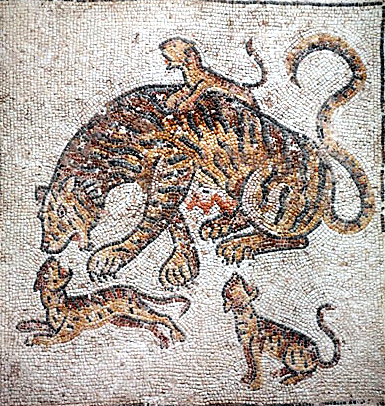 From
portraits of local wildlife to dramatic athletic contests, mosaics
provide a glimpse of who the Romans were and what they valued. They
became a popular art form during Roman times, appearing on floors in
both private homes and public buildings as early as the 2nd century BCE. From
portraits of local wildlife to dramatic athletic contests, mosaics
provide a glimpse of who the Romans were and what they valued. They
became a popular art form during Roman times, appearing on floors in
both private homes and public buildings as early as the 2nd century BCE.
The Romans created their mosaics using small pieces of glass or stone,
which they called tesserae. Originally they used only small,
colorful stones, but later cut large panels of stones into tesserae
to ensure the same shape and size of each piece. They chose marble
and limestone. the two most commonly used stones, because they were
soft, would break easily into predictable shapes, and naturally came in
a variety of colors.
Though the Romans perfected mosaics as an art form, it was the Greeks
who refined the art of figural mosaics by embedding pebbles in mortar.
The Romans took mosaics to the next level by using tesserae—cubes
of stone, ceramic, or glass—to form intricate, colorful designs. Action
scenes, violent hunts, exotic creatures, and mythological episodes all
became subjects of mosaics.
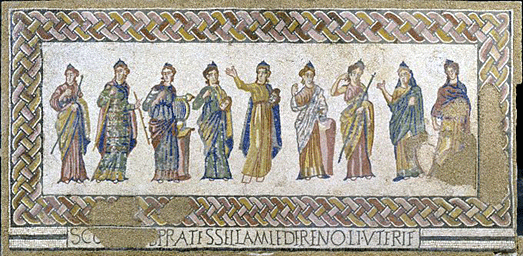
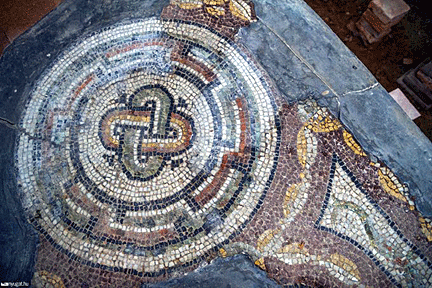 Roman
artisans constructed mosaics from geometrical blocks called tesserae,
placed together to create the shapes of figures, motifs and patterns.
They obtained materials for tesserae from local sources of
natural stone, with the additions of cut brick, tile and pottery
creating colored shades of, predominantly, blue, black, red, white and
yellow. Polychrome patterns were most common, but also created
monochrome mosaics. Marble and glass were occasionally used as
tesserae, as were small pebbles, and precious metals like gold. Roman
artisans constructed mosaics from geometrical blocks called tesserae,
placed together to create the shapes of figures, motifs and patterns.
They obtained materials for tesserae from local sources of
natural stone, with the additions of cut brick, tile and pottery
creating colored shades of, predominantly, blue, black, red, white and
yellow. Polychrome patterns were most common, but also created
monochrome mosaics. Marble and glass were occasionally used as
tesserae, as were small pebbles, and precious metals like gold.
These tesserae tiles measure between 0.5 and 1.5 cm, while fine
details were often created with even smaller pieces, some as tiny as 1mm
in size. Mosaic decoration was not just confined to floors but featured
on walls and vaults as well. Traces of guidelines have been found
beneath some mosaics, either scored into or painted onto the mortar
bedding. The design might also be pegged out in string, or mounted in a
wooden frame.
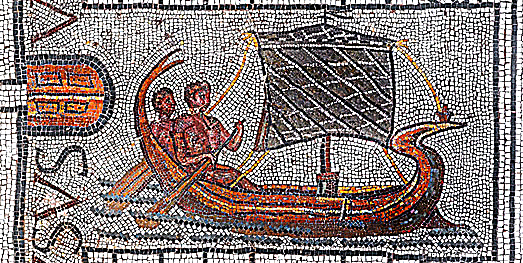
Roman mosaics came in two types—opus vermiculatum and opus
tessellatum. Opus vermiculatum used only tesserae of four
millimeters or less, allowing the artists to create lots of detail and
make a mosaic that looks almost like a painting. Since this was
expensive and time consuming, sometimes artisans created only small
panels of opus vermiculatum, called emblemata, which they
would insert into a mosaic for greater detail of specific parts. The
more common technique, opus tessellatum, used larger tesserae of varying
sizes, which limited the amount of detail that was possible, but they
were cheaper to make.
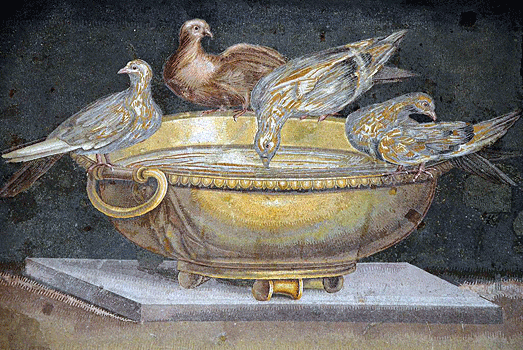
Roman mosaics were waterproof and easy to clean, making them ideal for
use in public buildings and baths.
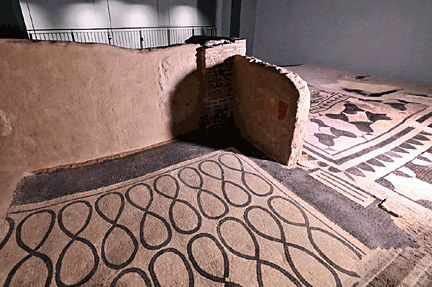 Artisans
used larger pieces of tesserae with a limited number of colors,
often using just black and white in designs with simple motifs, on
earlier examples of mosaics. Artisans
used larger pieces of tesserae with a limited number of colors,
often using just black and white in designs with simple motifs, on
earlier examples of mosaics.
The Romans made mosaics
to be walked on. While paintings covered the interior walls of Roman
villas, they weren’t practical for decorating floors. The Romans
designed them to be seen from different angles and to change as a person
moved over them.
At the same time, mosaics became symbols of wealth and status for the
Romans. Blending art and home décor, wealthy Romans commissioned mosaics
to adorn the interiors of their homes and impress guests, often choosing
themes to reflect their status. Mythological stories might show off a
man’s education, while scenes of wild animals being captured for fights
in the arena might highlight his sponsorship of public games.
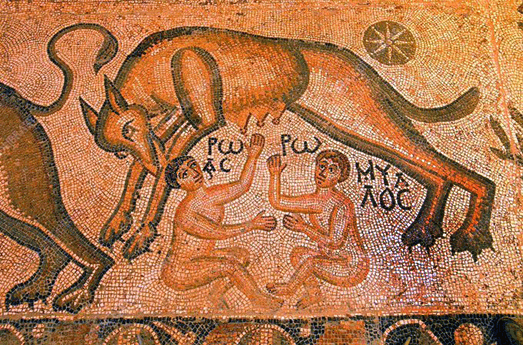
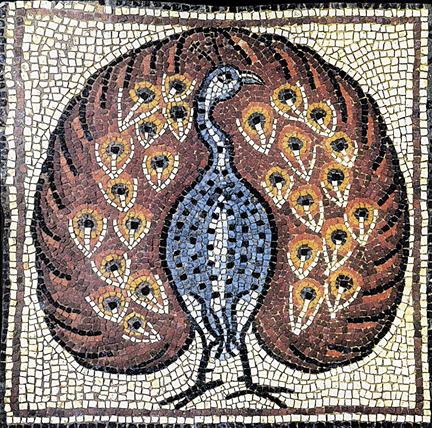 To
get special colors, mosaic artisans used glass and imported stones.
Though they relied on local stones for much of their work, they imported
unusual colors for special highlights. When no stone would do, they
turned to glass in bright colors like blue and green. To
get special colors, mosaic artisans used glass and imported stones.
Though they relied on local stones for much of their work, they imported
unusual colors for special highlights. When no stone would do, they
turned to glass in bright colors like blue and green.
The most detailed Roman mosaics consist of small stones to achieve a
brushstroke effect. Artisans “painted” with stone, using small, vivid
tesserae that resemble Pointillist daubs of color.
The spread of mosaics parallels the expansion of the Roman Empire, from
France to Syria to Tunisia. And like the rest of Roman culture, mosaics
in different places revealed a combination of local traditions and Roman
influence.
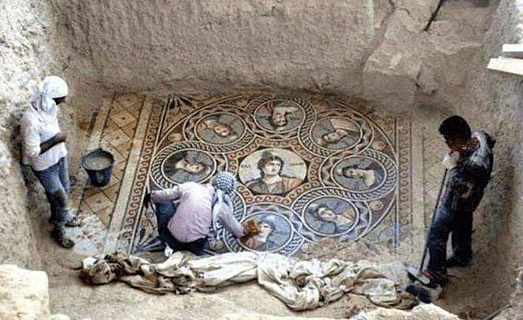
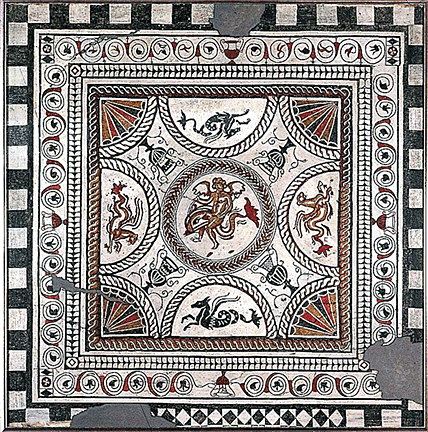 And
as with other art forms, mosaic artists had different styles. And
as with other art forms, mosaic artists had different styles.
Imagery of famous individuals or entertaining scenes could be found in
many Roman mosaics. The Alexander Mosaic from the House of the Faun in
Pompeii shows the Battle of Issus between Alexander the Great and Darius
III. In addition to famous people from antiquity, mosaics also depicted
scenes of daily Roman life. The Gladiator Mosaic from Rome features a
fighting scene, naming each gladiator involved. Orpheus mosaics, which
often include many animals drawn by the god's playing, were common.
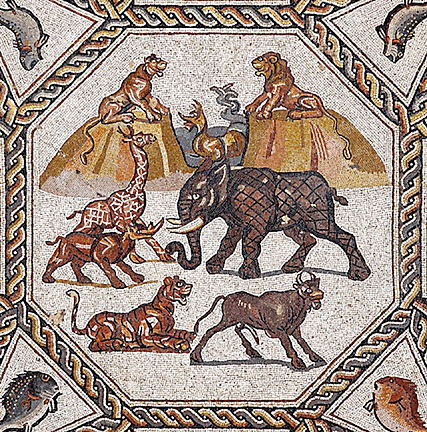 Because
of the effort and dedication that mosaic artwork tends to require, the
early intricate mosaics were often small. The usual size was 40x40cm
laid on a rimmed or marbled tray in a mosaic specialist workshop. These
pieces were called emblematas or the “hearts” of mosaics. They
were so valuable that Romans often removed them to re-use them again
elsewhere or handed down from generation to generation as a family
heirlooms. Because
of the effort and dedication that mosaic artwork tends to require, the
early intricate mosaics were often small. The usual size was 40x40cm
laid on a rimmed or marbled tray in a mosaic specialist workshop. These
pieces were called emblematas or the “hearts” of mosaics. They
were so valuable that Romans often removed them to re-use them again
elsewhere or handed down from generation to generation as a family
heirlooms.
The earliest mosaics of Roman Pompeii, dated to the Pompeian First Style
of wall painting in the late 2nd and early 1st centuries BC, were
clearly derived from the Hellenistic Greek model. However, they
contained far more figured scenes on average, less abstract design, the
absence of lead strips, as well as an almost complete lack of complex,
three-dimensional scenes utilizing polychromy until the Pompeian Second
Style of wall painting (80-20 BC).
<
More Special Features
Next
Article > |
